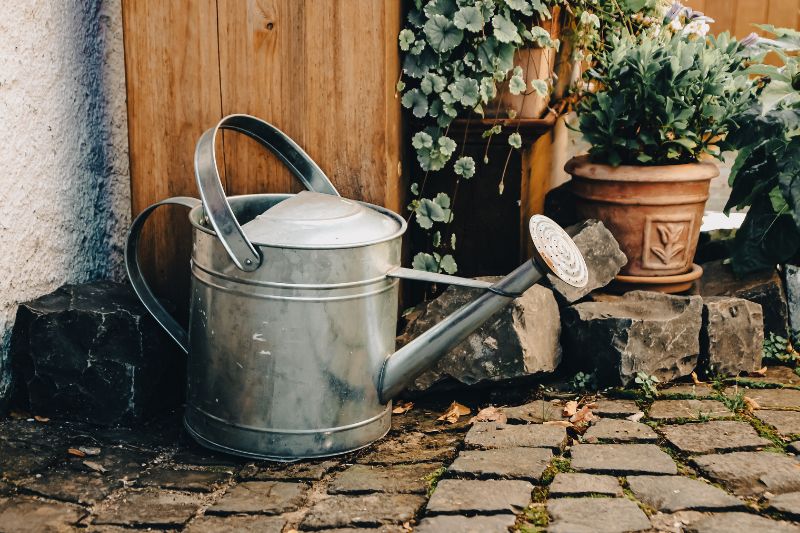Watering your plants may seem simple, but bad habits can harm their growth. Too much or too little water, the wrong timing, or incorrect methods… Here’s a guide to watering your plants properly and keeping them in top condition.
Understanding Your Plants' Needs
Not all plants have the same water requirements. Before watering, consider:
- The type of plant: Cacti and succulents need very little water, while tropical plants and vegetables require regular watering.
- Sun exposure: A plant in full sun dries out faster than one in the shade.
- The type of soil: Sandy soil retains less water than clay soil.
- The planting method: Soil in the ground dries out more slowly than in pots.
Tip: Insert your finger into the soil or compost about 2–3 cm deep. If it feels dry, it’s time to water.
Special Cases Requiring Extra Attention
- Potted plants dry out faster than those in the ground, especially if exposed to sun or wind. Check the moisture of the compost regularly, as water evaporates more quickly in containers. In summer, some plants may need almost daily watering. Also note that the substrate dries out faster in terracotta pots, as this porous material allows water to evaporate through its walls, unlike plastic, which is non-porous and retains more moisture.
- Seedlings need slightly moist soil to germinate properly, but avoid overwatering, which can cause rot. Use a spray bottle to water gently and avoid dislodging them.
- Newly planted plants haven’t yet developed deep roots, making them more vulnerable to water shortages. Water them more frequently for the first few weeks until they establish themselves. Once well-rooted, you can space out the watering.

When to Water?
The time of day matters to avoid waste and ensure water is absorbed by the roots.
- Morning: This is the best time, as the water has time to soak in before evaporation from the sun.
- Evening: Also a good option, especially in summer, but avoid excess moisture in winter to reduce the risk of disease.
- Midday: Avoid this time, as water evaporates too quickly and can even scorch leaves exposed to the sun.
Watering Also Depends on the Season.
| Period / Location | Watering Frequency | Practical Tips |
|---|---|---|
| ? Spring / ☀️ Summer | 1–2 times a week (or more in extreme heat) | Water early in the morning or evening. Monitor pots, which dry out quickly. |
| ? Autumn / ❄️ Winter | Every 10–15 days, sometimes less | Let the soil dry out between waterings. Avoid excess moisture. |
| ? Indoor Plants | About once a week | Adjust based on room temperature. Less water in winter. |
| ? Outdoor Plants | 2–3 times a week in summer, less in winter | Wind and sun dry out soil faster. Check soil regularly. |
How Much Water to Use?
It’s better to water less frequently but deeply rather than small amounts too often.
- A generous watering allows water to reach deep roots.
- Space out watering to avoid excess moisture, which can cause root rot.
- Adjust according to the season: More water in summer, less in winter.
Tip: If water runs off without soaking into the soil, give a light watering first, wait a few minutes, then water again.
How to Water Effectively?
- Water at the base of plants to prevent water from pooling on leaves, which can encourage disease.
- Use the right tools:
- A watering can with a rose for seedlings and young plants.
- A hose or drip system for the garden.
- A spray bottle for indoor plants that thrive in humidity (orchids, ferns).
- Mulch the soil: Adding mulch (straw, bark, grass clippings) around plants helps retain moisture and reduces watering frequency.
Good to know: Mosquitoes breed in stagnant water without predators to control them. This includes water reserves, abandoned buckets, or saucers under pots. Remember to empty them to prevent infestations!

Tips to Save Water
- Collect rainwater for natural and economical watering.
- Use self-watering pots to reduce evaporation.
- Group plants with similar needs to optimise watering.
Watering: Key Takeaways
| ✅ What to Do | ? What to Avoid |
|---|---|
| Check soil moisture with your finger before watering | Watering without checking soil moisture |
| Water preferably in the morning | Watering in full sun (risk of evaporation + scorching) |
| Water deeply but less often | Frequent light watering that doesn’t reach roots |
| Adjust according to season and exposure | Sticking to the same routine year-round |
| Water at the base, not on leaves | Letting water pool on foliage (encourages disease) |
| Mulch soil to retain moisture | Leaving soil bare, especially in summer |
































Comments